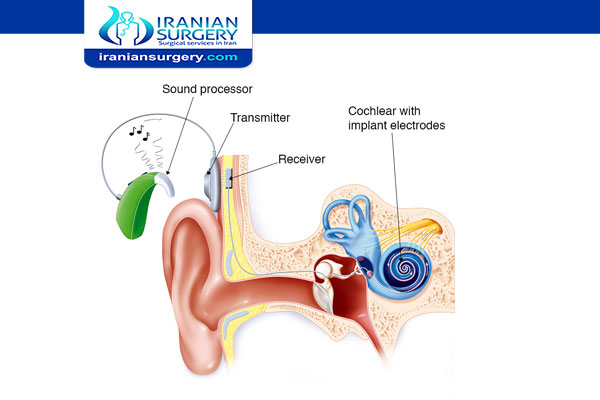Cochlear implant parts

Cochlear Implant Parts
Parts of a Cochlear Implant
All cochlear implants, regardless of manufacturer, consist of two general components:
. Internal device: The internal portion of the implant consists of two parts: the receiver/stimulator and the intracochlear electrode array.
. External hardware: The external portion consists of three parts: a microphone, a speech processor, and a transmitting coil.
Read more about : Cochlear implant pros and cons
How a Cochlear Implant Works
. Sound is picked up by the microphone, where it is sent down a cord to the speech processor.
. The speech processor filters the incoming acoustic signal into separate frequency bands, and then converts this information into digital form.
. The digitized signal is sent back up the cord to the transmitting coil, which is held in place by a magnet.
. The coil transmits the digitized information across the skin to the internal receiver/stimulator.
. The internal receiver/stimulator decodes the incoming signal and sends information in each frequency band to a different electrode within the cochlea. (The internal receiver/stimulator also contains a magnet to which the external coil sticks.)
. High-frequency information is sent to electrodes in the basal end of the cochlea, and low-frequency information is sent to electrodes in the apical end of the cochlea.
. Electrical stimulation from the intracochlear electrodes takes the place of damaged cochlear structures or hair cell - nerve synapses.
. The auditory nerve picks up the electrical signals from the electrodes and relays that information to the brain where it is interpreted as sound.
What does cochlear implant surgery entail?
If your doctors decide you could benefit from a cochlear implant, they’ll explain what it entails and schedule the surgery.
Here’s what usually happens:
. Before the surgery, you’re given general anesthesia to make you sleep.
. Once you’re asleep, your surgeon creates an incision behind your ear and makes a slight indentation in the mastoid bone.
. Your surgeon makes a tiny hole in the cochlea. They then insert the electrodes through the hole.
. Next, they insert the receiver behind your ear, beneath the skin. They secure it to the skull and stitch the incision.
. Once the surgery is complete, you’ll be moved to the recovery unit, where you wake up. You’ll be closely monitored to make sure you don’t have any side effects from the surgery.
. You’ll typically be discharged a few hours after the surgery or the next day.
Before you leave the hospital, a healthcare professional will show you how to care for the incision.
You’ll have a follow-up appointment about a week later, so your surgeon can check the incision and see how it’s healing. The incision needs to heal before the implant is activated.

